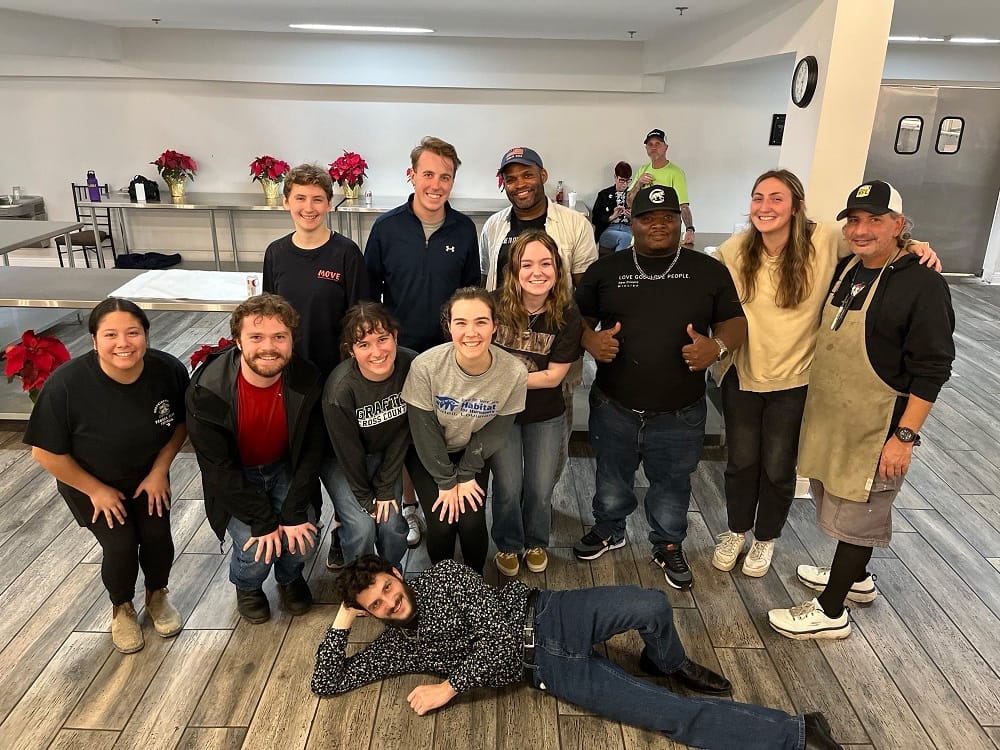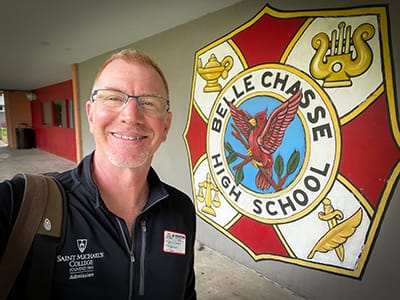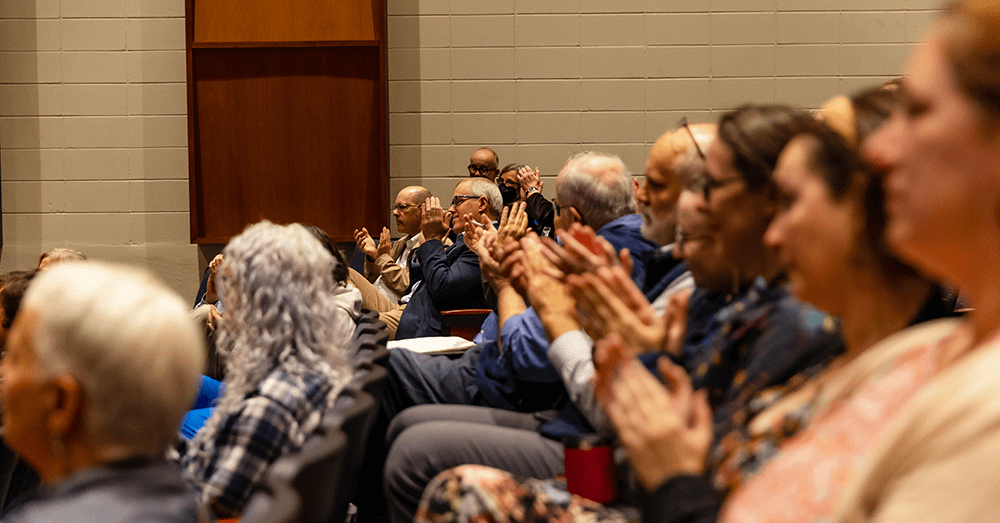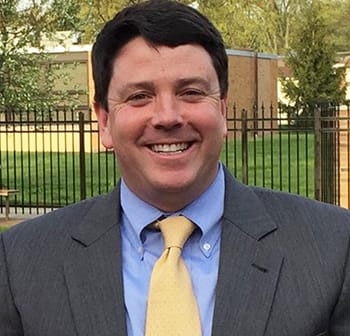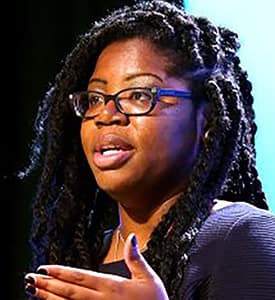In new space, education is what you make of it
High-visibility space custom-designed for creative tinkerers with a high-tech flair opened recently in the Dion Family Student Center at Saint Michael’s College.
A small crowd gathered on Tuesday afternoon, September 15, for the Grand Opening of “MakerSpace” — the new name based on a recent student contest and vote for the area on Dion Family Student Center’s first floor just past Einstein’s.
Formerly the Digital Lounge during Dion’s first two years, the space now contains three 3D printers – one, possibly the first of its kind in Vermont, uses paper as its printing medium, while the others “3D-print” using different qualities of plastic. There’s also a laser-cutter that can etch or cut glass, acrylic, stone and wood; a 3D scanner, a vinyl cutter, a sewing machine, materials for building Lego-robots – and of course, computers to design projects and connect student-designers to the more advanced tools. Counters and tall stools provide comfortable and practical work spaces in a large bright room that is visible through a glass wall to the heavy Dion student through-traffic or to campus tours.
Unlike most projects, MakerSpace has “no intended deliverables,” said Bill Anderson, chief information officer, in brief remarks at a two-hour Grand Opening that included an extended open house, along with cider and doughnuts.
“Most of this is about process, but at the same time, it’s also about unintended consequences,” said Anderson. For instance, Academic Affairs recently had IT staff and student workers make signs for office doors, while Enrollment and Marketing already has started using the space to make keychains with customized names to give to students who come on tours.
“It’s exciting to already see uses emerge like that for the space that nobody ever necessarily planned,” said Anderson. That was the whole idea … The president and cabinet decided this was really worth an experiment.”
Joe Pawlacyzk of the IT staff, who with colleague Susan Breeyear primarily saw the project’s logistics through from conceptualization to Tuesday’s opening, explained how the idea for MakerSpace evolved: “About a year ago we had a bunch of faculty working in different teams, some from biology interested in 3D printing for bones, another group needing a room to build robots in, and some art faculty interested in equipment to extend some things they do in their classes – and we realized a lot of this really could go together in one room and get some synergy between different types of equipment,” he said.
Aware of an administration desire to repurpose and maximize the prominent and visible Dion space, Pawlacyzk, Breeyear and others began planning, with the goal “to make this environment very welcoming to students, who could easily see a lot of different tools in here that might stir an interest.”
An early true-believer in the concept of MakerSpace was sophomore Nicole Kordana ’18, a biology major from Bernardston, MA, who is one of 15 Saint Michael’s students now trained to oversee the facility and guide visitors in use of technology there.
Wearing a custom work-apron bearing her name — something all of the 15 created for themselves — Nicole was working over the summer for the IT Department, and so had early close access when new machines began arriving and getting set up. “I’m personally excited as a biology major to model bones or other intricate things like cells that you can hold in your hand to help understand a structure,” she said. “But I’ve seen so many applications beyond that already.”
For instance, she said, some other newly trained students from the Video Game Club have been coming in and modeling characters they’re designing for their own video games. “And faculty are coming in already to explore new uses, and I love meeting them,” she said. “I’m learning so much about everyone in every department. I think it’s a great way to be more ‘hands-on’ in learning.” One student, who makes snowflake-designs by hand with an exacto knife, took a picture of one creation, put it in the laser cutter, and his 3D version is on the wall of the space, Pawlaczyk said.
He said Kordana and the 14 other students trained using a brief online course or with staff and vendor trainers in the space and also at a similar and more expansive pay-to-use space in downtown Burlington’s Memorial Auditorium lower-level called The Generator. The 15 include two interns, three leaders including Kordana, and 10 work-study students who were randomly assigned to the department. “But we met them, and they all fell in love with the space, so we took a week to extensively train them on each machine in there — and they caught on insanely quick. I’m so proud of them!” said Kordana, who used the MakerSpace sewing machine to sew pillows now on a window-sill seat in the room.
Students will staff the space between 1 p.m. and 9 p.m. on most days. Pawlaczyk said if a student comes in “with an idea but no technical experience, we’ll show you how to work things, have you take a little online course to get certified in about an hour, and when you’re comfortable, you can do it on your own.” He said the same easily-understood and applied Adobe-illustrator-based software drives most of the main machines.
Sue Breeyear of the IT staff said the project came together amazingly quickly. “We did it in a month, since we only were able to get into this room on July 12, though we did a lot of planning and ordering leading up to that.” An outside designer came to help with some measuring and layout, but mostly it was IT staff members who brought the logistics together. Breeyear said the 3D printers are enclosed in a paneled-off area “since we don’t’ want people using it when there’s not staff on duty.”
“I really wanted to make this a place that can be a blend of science and the humanities and arts so that it was useful to all disciplines and interests,” she said. “That was really deliberate, so it would not only appeal to ‘techies,’ but also maybe to those who want to do more craft-type things. We’re hoping we’ll see project overlap, with one thing building off of another.”
Said Vice President Patrick Gallivan in introductory remarks for the Grand Opening, “President Neuhauser and the cabinet saw real potential here … to make creativity happen and come to life … and what better demonstration of what liberal arts education should be?”
